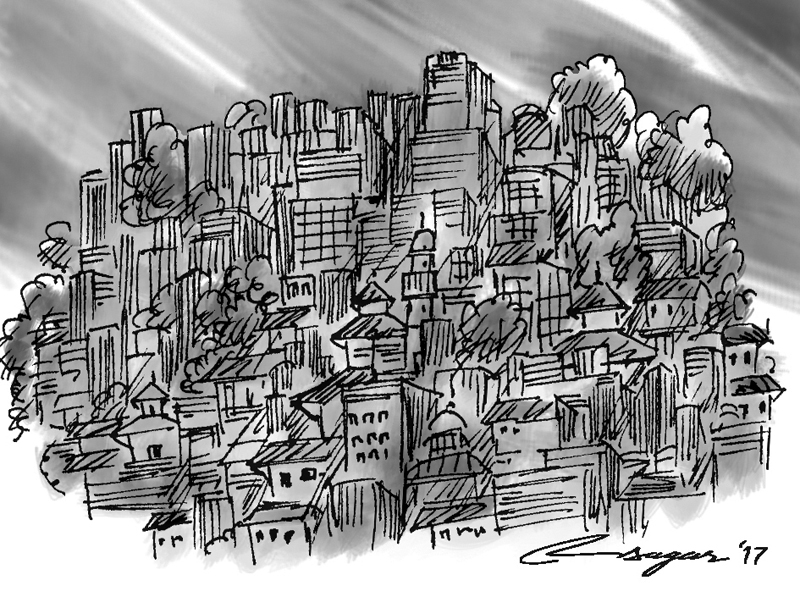Culture and heritage: Let Kathmandu survive
Risking geopolitics and restraining unwise development is the first step. We lost the regal trails of circuit Annapurna and wiped the virgin trails of Mustang in the name of development
Stricken by conservative development definitions, striding for dreams and vibrant lifestyles, striving for cornucopia underneath the foggy and smoky stratosphere with unraveled majesty of diamonds standing right in front; suddenly Kathmandu had a dream! The title is akin to Martin Luther King’s ‘I have a dream!’
Blasphemy occurred, time and again in several gloomy nights of Kathmandu. The dream was somehow horrific as it started with divided people in the name of caste, race and beliefs. Heritages were flattened and people cared for the ones which belonged to their descents!
Raised voices by looking at the surnames and origin, trashed humanity at times, extremely atrophied canes of household savage, communal tensions and regional likelihoods skewed the sacred road to the majestic screes of Yela [Patan].
The dream rolled on, a haphazardly treated rewind appeared on timeline, untangled glories that bamboozled even the modernity. The science, art, architecture and vernacularism -- everything sued the dreamer. Stacked chariots, brick paved roads, terracotta flavors, occurred in the center. Apart from it, miraculous ‘Kanth’ starred songs to subalterns, a synchronization of rarity, dependence and reinforcement of mutualism.
Every morning, awakened Kathmandu goes nowhere, except for the rusted, dusted and busted city trails and embezzled vehicles laden with human presence ejecting every possible air particle! Little things it does, Kathmandu doesn’t get a chance to grow into a cycle city, neither muscles are used even for small distances. Sneaky policies come across, Kathmandu must go to eternity.
Policies come across, expand beyond the limit, disdained and reckless. Kathmandu needs to destroy its heritage for road expansion but Kathmandu never holds the good position to be the capital! Rather it is a cultural capital. Brainstorming goes unwanted, with waned planning and idiosyncrasies endangered.
The art, architecture, history, culture is no more at the stratum but rather diverted, derided and destroyed. As I walk through the narrow street of Sundhara to have tea in an infamous but age old tea shop of Patan in a drizzling afternoon with buddies, I become wet due to potholes’ sprinkling. Brick pavements never did so. The pavement absorbed water for humanity. Facility, technology and intuition ruined! What does development mean?
Literally, it means concrete pavements up to front door, wipe our bicycles and brawl to get a narrowed vehicle, badly engineered as it neither allows you to sit nor stand. Public spaces are occupied by vendors, functions obstructed and rituals compromised. For the smoky night of candle lightning ceremony to the chariot, I squandered hours just to reach Patan from Jawlakhel.
Is there respect? Respect for humanity, city, culture and urbanism. Urbanism in the past survived with prayers to nature; a prayer that respected the city for letting us be there.
Prayers to the culture that made our civilization majestic, prayers to the nature that presented such gifts to us and prayers to the living tangibility and intangibility that taught us to be humankind. Carved into the Tudals, our civilization breathed but it’s in a coma now. As the last dream of Kathmandu was a byproduct of disequilibrium in human-nature-culture sphere.
They are planning for road extension and new settlements wiping out arable lands that do not satisfy the criteria to build houses. Going green, relocation of administrative centers and decentralization of facilities lead to controlled population in Kathmandu.
A biking lane beside the road is a must to fulfill the Kathmanduites’ clamor to revive the medieval flavor. Rivers could find their ways and Kaanth can still conserve the august, veritable and fashioned livelihoods. As the airbus comes down from the peaks, eyes voyage in the slapdash of concrete that lost color primarily after 1990.
This triggers almost every mind to get rid of the slumps as soon as possible although our projection of tourist arrivals and stay remain traversing. A well-traveled heritage maven, Randolph Langebach, wrote a very long letter recently. His were grave concerns regarding the unrestrained motor drivers that are indeed threats to other travelers and pedestrians.
Moreover, his remark, “I have traveled to very poor states across Africa but I did find nothing rambling and unconstrained like in Nepal. Why don’t you carve the august art and architecture with due management that would attract hundreds of thousands of more people?” As a citizen, rather as an aware citizen and member of civil society, such a remark triggered my hypothalamus. Risking geopolitics and restraining unwise development is the first step.
We lost the regal trails of circuit Annapurna and wiped the virgin trails of Mustang in the name of development, that literally meant rolling backhoes and creating unstable slopes to virgin trails. None pondered to do cost-benefit analysis of such projects, neither did they for Chandragiri cable car and others. Every morning, when I wake up my terrace displays the green panorama of Chandragiri, but with continued intervention?
Kathmandu’s soliloquy ends on the colloquial “Jhigu Yela tasaka bala” [Our Patan is awesome]. Kathmandu is a brand in itself, history noted the sustainability and sustainability relied on ergonomics as they offered prayers to Panchatatvas (five elements) that recount being “down to earth”.
To conclude, history can’t be replicated into wax idols and making history livable means accept, endorse, tolerate and let them grow. Let Kathmandu survive!
Gautam is a researcher in Structural Earthquake Engineering.






